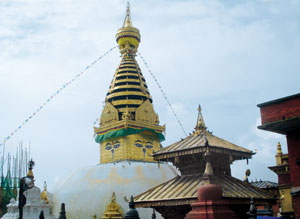By Suzanne Byan-Parker

Art and science. Buddhism and Hinduism. Religion and medicine. Interdisciplinary education is a hallmark of UAB courses, but two faculty members took that boundary-bending mindset to new heights this summer for a unique Study Away experience. In July, Cynthia Ryan, Ph.D., an associate professor in the Department of English, and Cathleen Cummings, Ph.D., an assistant professor in the Department of Art and History, took a group of students to the Kathmandu Valley for a three-week immersion in the art, history, culture, religion, and medical practices of Nepal. Kathmandu is the gateway to Mount Everest and the rest of the Himalayas, but it is also a major attraction in its own right, a vast metropolis of more than one million people and a complex cauldron of cultures. Ryan and Cummings designed a curriculum that allowed students to experience the Kathmandu Valley on multiple levels. Immersive ExperienceNepal, which is home to large contingents of Hindus and Buddhists, “is the only country in the world where both traditions thrive side by side,” says Cummings. Like the great cathedrals of Europe, Nepal’s temples are architectural works of art, she says. But sculpture, paintings, and ritual objects representing Hindu and Buddhist deities are not confined to temples, Cummings notes—they permeate Nepalese life. “Visiting Kathmandu’s religious and historical sites allowed students to observe directly the ways in which art reflects and shapes society.” Ryan’s course, which included visits to faith healers and meditation centers, an encounter with a traditional funeral procession, and a tour of a cancer hospital, asked students to examine the contradictions and complexities inherent in the Nepalese blending of religion and science. Whereas Western medicine views the body as a machine and illness as a mechanical error, Buddhist and Hindu traditions take a holistic approach, addressing both physical and spiritual dimensions. It is one thing to discuss these issues in a classroom in Birmingham, and quite another to take them in on the streets of Kathmandu, Ryan says. “We should not attempt to pretend that talking about a cancer hospital in Bhaktupar, Nepal, is as meaningful as touring the facility, pausing to read the educational materials covering the walls, or talking with staff and patients.” Life and Its MeaningsThe paradoxical nature of life in Nepal attracted Katherine Mascia, a UAB student majoring in molecular biology with aspirations of practicing medicine. “Traditional Nepali medicine would not have the same meaning without the overarching presence of religion,” she says. “You can’t walk even a few blocks through Kathmandu without stumbling across a Hindu shrine or Buddhist bahal.” That point was best summed up by a sign Mascia saw during the trip advertising the “Buddha Dental Shop.” That unforgettable—and telling—discovery is the kind of serendipitous find that makes Study Away courses so valuable, Ryan says. “Despite our efforts, we can’t always make material as vivid in the classroom as we can by taking students to a site and letting them experience it firsthand.” More InformationRead firsthand accounts of the UAB trip at uab-nepal.blogspot.com. Learn more about Study Away experiences at UAB. |